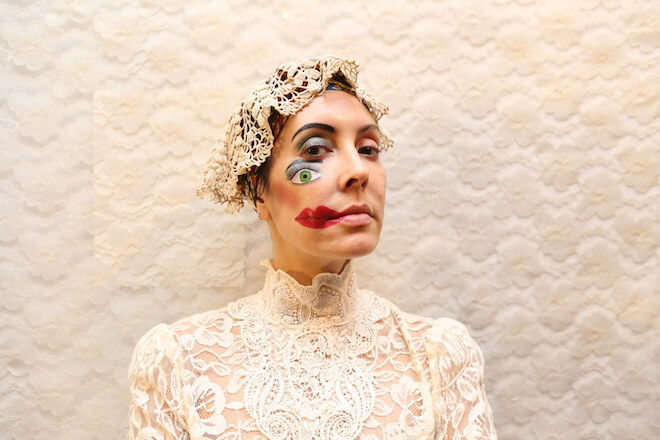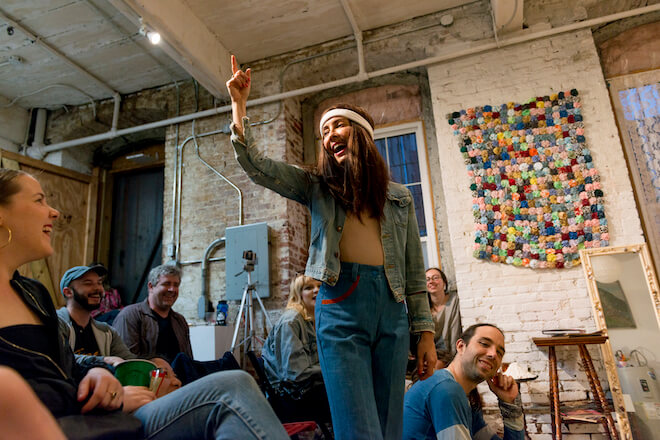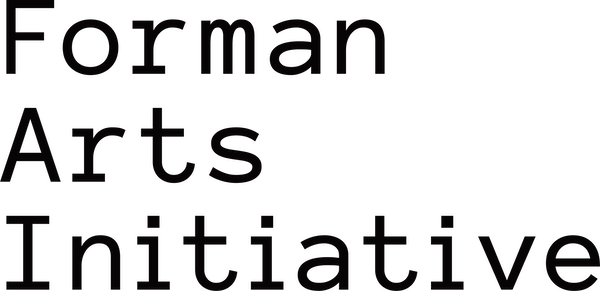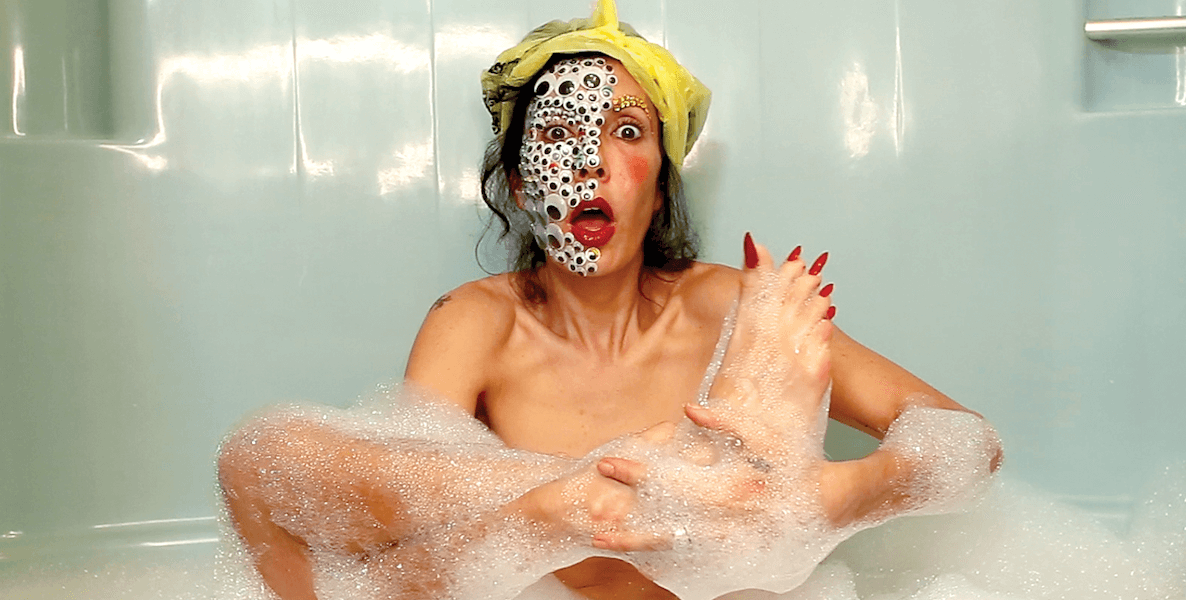Some mistakenly believe that the fine in fine art denotes qualities of sophistication — think a Van Gogh painting or a Brancusi sculpture. In truth, however, the “fine” in fine art refers to aesthetic purity — art created for the sake of art. Within this sense, Rose Luardo is one of the finest artists in Philadelphia. Luardo moved to the city in the late 90s and has been inciting chaos in the underground arts scene ever since. She is a performer, comedian, dancer, visual artist, and general prankster whose work delves into the strange, sexual, and satirical sides of life.
Luardo prefers her comedy to be “found in the gutter,” even if that means an audience member or two may leave her shows more disgusted than tickled. Within the last year, Luardo completed a run of Pedestrian Circus, a one-woman show where Luardo transforms into five characters. Pedestrian Circus highlighted Luardo’s knack for persistence in the face of surmounting discomfort, a skill necessary in the world of comedy. “I just think I came out of the vagina really intense,” Luardo states, “You have to work the way you like to work.”

Logan Cryer: What’s been your experience as an artist in Philadelphia?
Rose Luardo: I grew up in Wynnewood, … just west of West Philly. I had been living in NYC and moved to Philly because I had friends that were thriving here and I could be closer to my family.
My friends that were living in Philadelphia were like, “This place is fucking great. It’s like a real freak show.” When I got here in ’97, if you wanted to live alone, you still could afford to live alone. My first apartment might have been $395. And I will say, maybe a lot of people didn’t want to be here; it was still rough as hell, but it was so Armageddon, lawless. And I feel that there’s a lot of creativity in spaces like that.
There were a lot of people that had graduated from RISD [Rhode Island School of Design] that came here and started Space 1026. I really liked the energy of the things that were happening there. And it was a place where it was like, “Let’s just stand this up and see what happens. Let’s just put on this art show. Let’s just have this sculptural, piñata, food, experimental sculpture garden thing and see what happens.” The things that were happening were amazing, super fucked up, not happening in other spaces and truly creative.
“There is art in partying and art in partying with people and art in dancing with people.”
I wouldn’t even say that now I have any sense of what my lane is. I’m just here leaning into my compulsions, leaning into my curiosities. Sometimes just meeting somebody, having a conversation, vibing with them, and then just seeing where it goes is part of what I enjoy creatively and otherwise.
I think a lot of people start projects now and they want to plan how to keep things sustainable, to do it forever. It doesn’t seem like that was Space 1026’s mission in the beginning.
Oh hell no. It was a skateboard park; it was a studio space. People were living there half the time. It was a free-for-all. It was a place where you could have an idea and put up a show. It was friendship based. It was fun based.
I loved that there was truly no editing and anything you wanted to do, somebody would get behind. No one said, “No.” The first show that I did was called Smash It, Break It, Eat It, and it was piñatas, papier-mâché and sculpture, all having to do with food. Somebody made a full skeleton out of bread that they carved. They made some of the bread themselves; they mushed together bagels. They took beignets and all these different kinds of breads that they purchased and then made and made a full long skeleton — in, I believe, a coffin. It was outrageous and felt very 1981 New York City, but it was 1997 Philadelphia. Things that were really well crafted and really well thought out, but didn’t have this heaviness or this insincerity. It was really accessible.
In addition to creating comedy and art, you also dance quite a bit. I’m curious, what is your relationship to dance?
Here’s my relationship: a long love affair with dance. My first communication with dance was watching really early MTV. I’m maybe in fourth or fifth grade and watching these elaborate dance routines in dance videos and being so blown away and then trying to recreate those movements in my house. I have always loved to move my body in those ways, but I didn’t go to kids’ jazz or kids’ ballet. I don’t know if you know this, but I was on a dance team for a long time that was called Club Lyfestile.
No, I’m not familiar with this.
Club Lyfestile was a 10-year project that I did with all of these people in Philadelphia in maybe 2007. A whole bunch of people came from Rutgers and came from Virginia. And they were living in this place that had a garage on the first level. They squatted in the next two levels, and they would have all these really crazy fucked up shows at their house. They started a dance team and they would go into the Jomar trash cans and dumpster dive all the spandex and made all these matching costumes and made up dances, these fucked up elaborate dances.
I saw them play at First Adventure Island. It was a punk performance place. And it blew me the fuck away. I was like, “Where do I sign up?” And then we performed together for 10 years. We went on three or four national tours. We bought one of those retirement community small buses and drove across the country. We performed on ferry boats, We were not that good, but we were incredible.
We played Whartscape. It’s in Baltimore. There’s an arts festival called Artscape, and there’s something called Whartscape, which is just fucking crazy art people that put together this festival. Dan Deacon was part of the Wham City crew that put that on. I really think that there is art in partying and art in partying with people and art in dancing with people. There’s an art to also DJing, to reading the crowd and moving people and getting people to move and express. And I would say I’m a kind of a dancer. I’m always trying to wear a leotard. I’m always trying to have the trappings and the trimmings of a professional dancer without really having any training.
“I want to approach creativity in as naive and innocent a way as I possibly can.”
I’ve had some people embrace me. Headlong Performance Institute — that felt like a dance embrace. Emmett Wilson is somebody who has embraced my dancerdom, dancer business. Good Good Comedy Theater let me dance. Andrew Jeffrey Wright is also another person who is a phenomenal dancer. And he and I would put on full performance blacks and move around and put it into comedy and really take the piss out of how dance is a world they don’t want you to play in unless you’ve had the training. They don’t want you to be there.
I don’t know still to this day how people see me as an art creature because I don’t know if anybody ever thinks that my practice is legitimate. I have no training, no bullshit, no stuff, no fancy clown degree, no Pig Iron. I do think that Headlong is fucking amazing. It’s the school that was willing to take somebody that was 37 and loved dance and was doing a lot of my own pedestrian dance. I thought it was very radical for a school that is a dance theater school to take people that had zero training and were fully-formed adults with fully-formed bones. And I do think I got a lot out of that, including the things that I decided I hated, which I think is a lot. It’s like having a bad therapist. I love having a bad therapist. I’m like, “I’m really getting something out of this and it’s what I hate.” I love to dig into that space. It’s very clarifying.

Something I’ve noticed in your work is this approaching sense of dread. Does that sound right to you?
Sure. I think it’s a lot of satire. And I think you have to be able to hang out in that place in order to laugh. I think that people are hysterical. People are dropping gifts all over the place with their insanity. I really let everybody choose their own adventure with the way they want to approach my work. I feel once I’ve feel I made anything, you are communing with what I did. And it might not be for some. I don’t know. I guess I try to steer clear of saying anything hard and fast about what I do because people can just define it the way they want to or not define it at all. And I think I don’t want to get locked into any definition, and I think I want to approach creativity in as naive and innocent a way as I possibly can.
“For my dollar, I think I want somebody to have a tsunami rush over them and to have a feeling of, ‘What the fuck is happening or how much of this is real? What’s going on?’”
Here’s the deal. I think that art is a feeling, the inhale/exhale, the smell of your breath, your eyelash, your fingernail. It should be more like a French kiss. It should be more like skin contact. I think when it gets too heady, it’s almost too processed. It’s like an Impossible Burger. If I was in somebody’s play and they really wanted to take it to that level, sure thing, man, I would be there to serve that goal. But for my dollar, I think I want somebody to have a tsunami rush over them and to have a feeling of, “What the fuck is happening or how much of this is real? What’s going on?”
It seems like you’ve given yourself a lot of permission to try things, and the fact that you’ve been doing this for such a long time and you’re still experimenting, it’s very rare.
I think that you have to cut your brain off. You have to stop asking questions. Just go and do the thing. I’ve worked with people that while we’re about to go out on stage, they’re like, “What if this isn’t any good?” And I’m like, bitch, first of all, is that really going to fry your labia? Then you have no business doing this. But also, so the fuck what? If you cannot handle your lead balloon, if you cannot handle smelling your own enema bag, then get out of this business.
You need a public ego bleed. You need to do a comedy set and no one laughed. You need to be asking yourself, “Should I get off the stage?” And you stay anyway. Some people’s art practices are designed to torment; that is a thing. But I’m not trying to hurt anybody’s feelings, I’m just trying to be out here high kicking it. At the end of the day, I would like to have the joy of being with people. And so maybe I’m in it for that, because that feels so rewarding.
Logan Cryer is a curator based in Philadelphia with a penchant for local art histories. They currently serve as the Co-Curator of Icebox Project Space and they like to rewatch documentaries.
 This story is part of a partnership between The Philadelphia Citizen and Forman Arts Initiative to highlight creatives in every neighborhood in Philadelphia. It will run on both The Citizen and FAI’s websites.
This story is part of a partnership between The Philadelphia Citizen and Forman Arts Initiative to highlight creatives in every neighborhood in Philadelphia. It will run on both The Citizen and FAI’s websites.
![]() MORE FROM OUR ART FOR CHANGE SERIES
MORE FROM OUR ART FOR CHANGE SERIES




